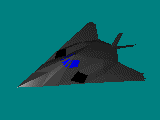Military
Fighters
F-14
F-15
F-16
F-17
F-18
AC-130
A-6
AV-8B
A-10
F-111
F-117
F-22
return
|

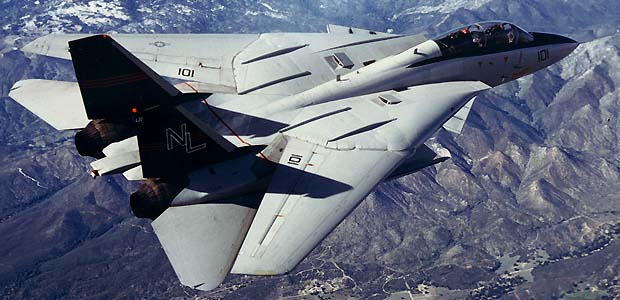
These aging
warriors of the Navy's fleet, which carry modern weapons, electronics
and engines, cost about $38 million each. F-14s can carry up to 13,000
pounds of ordnance, including Phoenix, Sparrow and Sidewinder missiles,
along with a 20 mm cannon.
|
F-14
Tomcat
Primary function: Carrier-based multirole strike
fighter
Speed: 1,484 mph (mach 2.0)
Armament: Up to 13,000 pounds to include AIM-54 Phoenix missile,
AIM-7 Sparrow missile, AIM-9 Sidewinder missile, air-to-ground precision
strike ordnance, and one M61A1/A2 Vulcan 20mm cannon.
Crew: Pilot and radar intercept officer
Propulsion:
F-14A: Two Pratt & Whitney TF-30P-414A turbofan engine with
afterburners. F-14B and F-14D: Two General Electric F110-GE-400 turbofan
engines with afterburners
Thrust:
TF-30P-414A: 20,900 pounds (9,405 kg) static thrust per engine,
F110-GE-400: 27,000 pounds (12,150 kg) static thrust per engine
Length:
61 feet 9 inches (18.6 meters)
Height:
16 feet (4.8 meters)
Wingspan:
64 feet (19 meters) unswept, 38 feet (11.4 meters) swept
Maximum
Takeoff Weight: 72,900 pounds (32,805 kg)
Ceiling:
Above 50,000 feet
Contractor:
Grumman Aerospace Corp.
Unit Cost:
$38 million
Date
Deployed: First flight: December 1970
|
http://www.airforce-technology.com/projects/f14/index.html
|


The F-15 is an
all-weather tactical fighter. Called the "Starship" by pilots,
the F-15 costs $15 million per plane and is the world's leading air
superiority fighter. It carries an M-61 A1 20 mm cannon, four Sidewinder
missiles and four Sparrow missiles.
|
F-15C
Eagle
Primary function: Tactical fighter
Speed:
1,875 mph (Mach 2.5 plus)
Crew:
one in F-15A/C, two for F-15B/D/E
Contractor:
McDonnell Douglas Corp.
Power
plant: Two Pratt & Whitney F100-PW-220 or 229 turbofan engines
with afterburners
Thrust:
(C/D models) 23,450 pounds each engine
Wing
span: 42.8 feet (13 meters)
Length:
63.8 feet (19.44 meters)
Height:
18.5 feet (5.6 meters)
Maximum
takeoff weight: (C/D models) 68,000 pounds (30,844 kilograms)
Ceiling:
65,000 feet (19,812 meters)
Range:
3,450 miles (3,000 nautical miles) ferry range with conformal fuel
tanks and three external fuel tanks
Armament:
One internally mounted M-61A1 20mm 20-mm, six-barrel cannon with 940
rounds of ammunition; four AIM-9L/M Sidewinder and four AIM-7F/M Sparrow
air-to-air missiles, or eight AIM-120 AMRAAMs, carried externally.
Unit
Cost: A/B models - $27.9 million (fiscal 98 constant dollars);C/D
models - $29.9 million (fiscal 98 constant dollars)
Date
deployed: July 1972
Inventory:
Active force, 396; Reserve, 0; ANG,126.
|
http://www.af.mil/news/factsheets/F_15_Eagle.html
|

The F-15E is a
special strike, or bomber, version of the F-15 fighter aircraft crewed
by a pilot and a weapon systems officer. The $31.1 million plane
features advanced laser and radar targeting systems, air-to-air
missiles. It can carry any bomb in the Air Force's inventory, including
the 5,000-pound GBU-28 "bunker buster" and the all-weather
2,000-pound AGM-130 guided missile.
|
F-15E
Strike Eagle
Primary function: Tactical fighter
Speed:
1,875 mph (Mach 2.5 plus)
Armament: Various air-to-air and air-to-ground missiles
Crew:
two for F-15B/D/E, one for F-15A/C
Contractor:
McDonnell Douglas Corp.
Power
plant: Two Pratt & Whitney F100-PW-220 or 229 turbofan engines
with afterburners
Thrust:
(C/D models) 23,450 pounds each engine
Wing
span: 42.8 feet (13 meters)
Length:
63.8 feet (19.44 meters)
Height:
18.5 feet (5.6 meters)
Maximum
takeoff weight: (C/D models) 68,000 pounds (30,844 kilograms)
Ceiling:
65,000 feet (19,812 meters)
Range:
3,450 miles (3,000 nautical miles) ferry range with conformal fuel
tanks and three external fuel tanks
Armament:
One internally mounted M-61A1 20mm 20-mm, six-barrel cannon with 940
rounds of ammunition; four AIM-9L/M Sidewinder and four AIM-7F/M Sparrow
air-to-air missiles, or eight AIM-120 AMRAAMs, carried externally.
Unit
Cost: A/B models - $27.9 million (fiscal 98 constant dollars);C/D
models - $29.9 million (fiscal 98 constant dollars)
Date
deployed: July 1972
Inventory:
Active force, 396; Reserve, 0; ANG,126.
|
http://www.af.mil/news/factsheets/F_15_Eagle.html
|
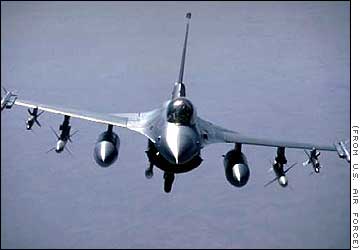

The F-16
Fighting Falcon is a small multi-role fighter aircraft known for its
exceptional maneuverability and diverse capabilities. Each F-16 costs
$20 million or more. It carries one M-61 A1 20 mm multibarrel cannon,
and up to six air-to-air missiles.
|
F-16
Fighting Falcon
Primary function: Multirole fighter jet
Speed: 1,500 mph (mach 2.0)
Power
Plant: One General Electric F110-GE-129 or Pratt and Whitney
F100-PW-229
Thrust:
F-16C/D, 27,000 pounds
Range:
More than 2,000 miles
Crew:
Crew: F-16C, one; F-16D, one or two
Wingspan:
32 feet, 8 inches (9.8 meters)
Length:
49 feet, 5 inches (14.8 meters)
Height:
16 feet (4.8 meters)
Empty
weight: 8,500 kg
Maximum
altitude: 50,000 ft
g
limit: 9g+
Armament:
Air-to-air combat and air-to-surface attack munitions. One M-61A1
20mm multibarrel cannon with 500 rounds; external stations can carry up
to six air-to-air missiles, conventional air-to-air and air-to-surface
munitions and electronic countermeasure pods
Maximum
Takeoff Weight: 37,500 lbs
Mfg:
Lockheed-Martin
Unit cost:
$20 million
Date
Deployed: January 1979
|
http://www.airforce-technology.com/projects/f16/index.html
|

|
F-17
Cobra
Primary function: fighter
Speed:
Armament:
Crew:
Mfg:
Northrop
Power Plant:
two General Electric 404-GE400
Length:
56'
Height:
15' 4"
Wingspan:
37' 6"
Gross
Weight: 44,000 lb
|
http://aeroweb.brooklyn.cuny.edu/specs/northrop/yf-17.htm
|
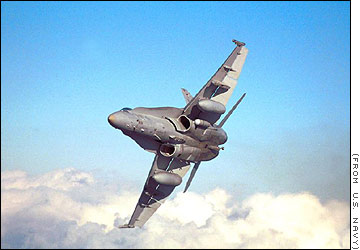
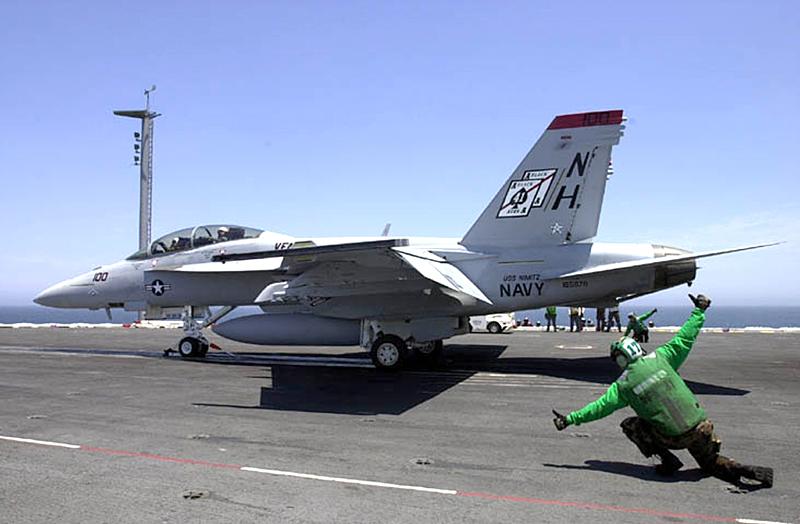
F/A-18 and
F/A-18C Hornets are dual-role attack aircraft and fighters. These
twin-engine, multipurpose aircraft can cost from $24 million to $35
million, depending on the type. Some versions carry crews of one, others
two. Maximum speed is Mach 1.7.
External
payload: AIM 9 Sidewinder, AIM 7 Sparrow, AIM-120 AMRAAM, Harpoon,
Harm, SLAM, SLAM-ER, Maverick missiles; Joint Stand-Off Weapon (JSOW);
Joint Direct Attack Munition (JDAM); various general purpose bombs,
mines and rockets.
|
FA-18
Hornet
Primary function: Multirole attack and fighter
aircraft
Speed: 1,261 mph (mach 1.7)
Armament: One M61A1/A2 Vulcan 20mm cannon
(6.000 shoots/min)
Weapons: Air/Air missiles: Sidewinder, Sparrow
and AMRAAM, Air/Ground: Maverick, Harpoon and HARM, Bombs: free fall, laser guided, and cluster.
Crew: A, C, and E models are pilot only while B, D, and F models are
two-seaters.
Length: 56
ft (17.1 m)
Height: 15.3
ft (4.7 m)
Wing Span: 40.4
ft (12.3 m)
Propulsion:
Enhanced Performance Engine (EPE): Two
F404-GE-402 engines, each in the 18,000 pound thrust class. Combat
thrust-to-weight ratio greater than one-to-one
Thrust:
17,700 pounds (8,027 kg) static thrust per engine
Maximum
Take Off Gross Weight: 51,900 pounds
Range:
1252.4 miles combat, 1777.9 ferry
Combat
Radius: 500+ nm
Combat
Ceiling: 50,000 ft
Contractor:
Prime: McDonnell Douglas; Major Subcontractor: Northrop
Unit Cost:
$24 million to $35 million
Date
Deployed:
First flight - November 1978
Operational - October 1983 (A/B models); September 1987 (C/D models)
|
Armament:
Up to 13,700 pounds
(6,227 kg) external ordnance. Nine weapon stations; two wingtip stations for
Sidewinders, two outboard wing stations for air-to-air or air-to-ground weapons,
two inboard wing stations for fuel tanks, air-to-air or air-to-ground weapons,
two nacelle fuselage stations for AMRAAMs, Sparrows or sensor pods, and one
centerline station for fuel or air-to-ground weapons. M61A1 20-mm gun internally
mounted in the nose.
http://www.boeing.com/defense-space/military/fa18/flash.html
(Hornet)
http://www.boeing.com/defense-space/military/fa18ef/flash.html
(Super Hornet)
http://www.dfrc.nasa.gov/gallery/photo/F-18SRA/index.html
(photos)
http://www.dfrc.nasa.gov/PAO/PAIS/HTML/FS-002-DFRC.html
(HARV)
http://www.fortunecity.com/campus/caldwell/375/F-18/F-18.html
http://private.freepage.de/monaco/f18.htm
(photos)
http://www.aire.org/462/ingles/pavioni.htm
http://privat.schlund.de/f/flugweb/f-18.htm
http://misc.info.kuzbass.net/bagus/avia/F-18/F-18.htm
|

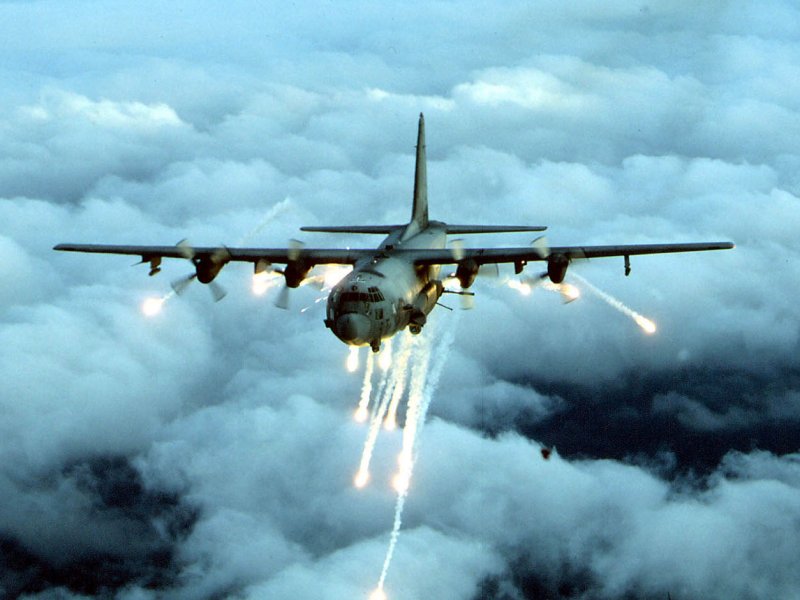
The AC-130
gunship's primary missions are close air support, air interdiction and
force protection. These heavily armed aircraft incorporate side-firing
weapons integrated with sophisticated sensors, navigation and fire
control systems to provide surgical firepower or area saturation during
extended periods, at night and in adverse weather.
|
AC-130H/U
Gunship
Primary function: Close air support, air
interdiction and force protection
Speed: 300 mph
Armament: AC-130H/U: 40mm cannon and 105mm cannon; AC-130U: 25mm
gun
Crew: Five officers (pilot, co-pilot, navigator, fire control
officer, electronic warfare officer) and eight enlisted (flight
engineer, TV operator, infrared detection set operator, loadmaster, four
aerial gunners)
Builder:
Lockheed/Boeing Corp.
Nickname:
AC-130H Spectre AC-130U Spooky
Power Plant:
Four Allison T56-A-15 turboprop engines
Thrust:
4,910 shaft horsepower each engine
Length:
97 feet, 9 inches (29.8 meters)
Height:
38 feet, 6 inches (11.7 meters)
Wingspan:
132 feet, 7 inches (40.4 meters)
Range:
Approximately 1,300 nautical miles; unlimited with air refueling.
Ceiling:
25,000 feet (7,576 meters)
Maximum
Takeoff Weight: 155,000 pounds (69,750 kilograms)
Unit Cost:
Between $132.4 million and $190 million
Inventory:
Active duty: AC-130H, 8; AC-130U, 13; Reserve, 0; ANG, 0
Video
MC-130
Flight
Test with AAR-44 ECM Video
|
http://www.globalsecurity.org/military/systems/aircraft/ac-130.htm
http://www.globalsecurity.org/military/systems/aircraft/ac-130-pics.htm
(photos)
http://www.specwarnet.com/vehicles/spectre.htm
|

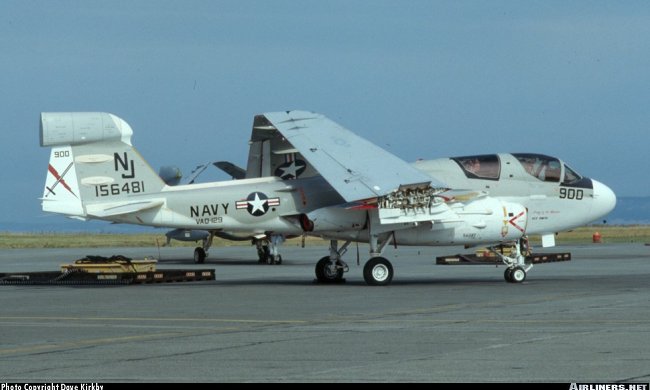
The A-6
Intruder recently retired as the Navy/Marine Corps medium attack
aircraft. This redoubtable aircraft has seen combat in Vietnam and the
Persian Gulf and was the star of the Hollywood film "Flight of the
Intruder." Together with its principal variant, the EA-6B Prowler
electronic warfare aircraft, the A-6 Intruder has earned its place in
aviation history.
95 Navy A-6s
flew 4,045 sorties. The Marines deployed 20 A-6's flying 854 missions
from land bases. Five A-6s were lost or damaged in combat; two early in
the war during low-altitude attacks.
Wing sweepback
25 degrees at quarter-chord; outer wing panels fold upward more than 90
degrees for stowage; TRAM ball under nose, aft of radome. Survivability
improvements incorporated; fire extinguishing system (halon) inerting
fuel tanks; fire suppression in areas around fuselage fuel tanks wing
dry foam blocks; and self-sealing fuel lines in engine cavities.
A little-known
fact is that the Intruder delivered more ordnance during the Vietnam War
than the B-52.
|
A-6
Intruder
Primary function: Carrier-based all-weather
attack aircraft, with tanker variant.
Speed: 474 mph cruise, 653 max, approach 127 mph
Armament: Five weapon attachment points, each with a 1633
kg (3600 lb) capacity (max external stores load 8165 kg; 18,000 lb).
Typical weapon loads are 28 500 lb bombs in clusters of six, or three
2000 lb general purpose bombs plus two 1135 litre (300 US gallon; 250
Imp gallon) drop tanks. AIM-9
Sidewinder can be carried for air-to-air use. Harpoon missile
capability added to weapons complement of A-6E/TRAM. The HARM missile
has been test flown on the A-6E. Up to 20 Brunswick Defense AN/ADM-141
TALD (Tactical Air-Launched Decoy) gliders, or two in addition to normal
bomb load. Flight and firing tests have been carried out with the
AGM-123A Skipper II, also on an A-6E.
Crew: 2
Power Plant:
Two Pratt & Whitney J52-P-8A turbojets
Thrust:
9300 lb
Length:
54 ft 9 in
Height:
16 ft 2 in
Wing span:
53 ft 0 in
Fuel load:
internal: 15,939 lb, external (five tanks): 10,050 lb
Fuel
Capacity: 2344 US gallons
Weight
empty: 27,613 lb
Max T-O
weight: catapult: 58,600 lb
Max landing
weight: carrier: 36,000 lb
Max rate of
climb: 7620 ft/min
Service
ceiling: 42,400 ft
Range with
max military load: 1011 miles
Range
without load: 3,300 miles
Mfg: Grumman
Date
Deployed: 1960 Test,
Date
Retired: 1997
Inventory:
482 Navy (A-6As) by 1963, 687 total
|
http://www.danshistory.com/a6.html
http://www.topedge.com/alley/images/a6/a6img.htm
(photos)
http://www.globalsecurity.org/military/systems/aircraft/a-6-pics.htm
(photos)
http://www.globalsecurity.org/military/systems/aircraft/a-6.htm
http://www.yellowairplane.com/pics/CV63_A6_1.htm
http://pacificcoastairmuseum.org/pcam_aircraft/a6/a6.html
http://www.state.sc.us/patpt/a6.htm
http://home.hetnet.nl/~wetting/index.html
(photos)
|

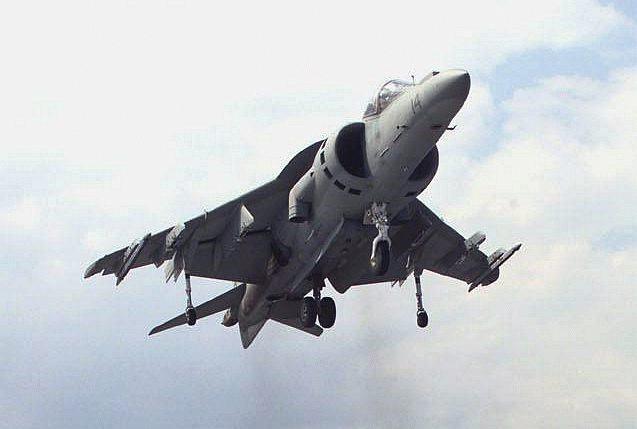
The
versatile, British-designed Harrier attack jet can take off and land
vertically, much like a helicopter. The $24 million aircraft has a top
speed approaching Mach 1 and carries both air-to-air and air-to-ground
weapons, including the missile. Harriers fought dramatically and
effectively in the British conflict with Argentina over the Falkland
Islands.
|
AV-8B
Harrier
Primary
Function: Attack and destroy surface targets under day and night
visual conditions.
Contractor:
McDonnell Douglas
Power Plant:
One Rolls Royce F402-RR-406 or F402-RR-408 turbofan engine
Thrust: F402-RR-406: 21,500 pounds, F402-44-208: 23,400 pounds
Length:
46.3 feet (14.11 meters)
Height:
11 feet, 7 inches
Wingspan:
30.3 feet (9.24 meters)
Speed:
630 mph, Subsonic to transonic
Ceiling:
Weight:
empty: 12,800 pounds
Maximum Takeoff Weight: 31,000 lbs short takeoff, 18,900 lbs for
vertical
Range: 1600 miles, 2416.64 miles (ferry)
Combat
radius: close air support: 163 nautical miles (187.45 miles) with
30 minutes time on station interdiction: 454 nautical miles (522.45
miles)
Armament: Seven external store stations, comprising six wing
stations for AIM-9 Sidewinder and an assortment of air-to-ground
weapons, external fuel tanks and AGM-65 Maverick missiles; one
centerline station for DECM pod or air-to-ground ordnance. A GAU-12 25MM
six-barrel gun pod can be mounted on the centerline and has a 300 round
capacity with a lead computing optical sight system (LCOSS) gunsight.
Crew:
One
Date Deployed:
12
January 1985, AV-8BII (Plus) introduced in June 1993.
Unit Cost:
Inventory:
|
http://www.history.navy.mil/planes/av8.htm
http://www.av8b.org/index.htm
http://www.av8b.org/website/us/aircraft.htm
(photos)
http://www.fas.org/man/dod-101/sys/ac/av-8.htm
(photos)
http://www.photovault.com/Link/Military/Marines/Aircraft/AV-8BHarrier.html
(photos)
http://www.danshistory.com/av8b.html
http://ppe.navair.navy.mil/aircraft/aircraft/av8.htm
http://www.globalsecurity.org/military/systems/aircraft/av-8.htm
http://www.periscopeone.com/demo/weapons/aircraft/attack/w0003089.html
http://the_kitsune.tripod.com/Rifts-Earth-Vehicles/GAW_AV8B_Harrier.htm
|
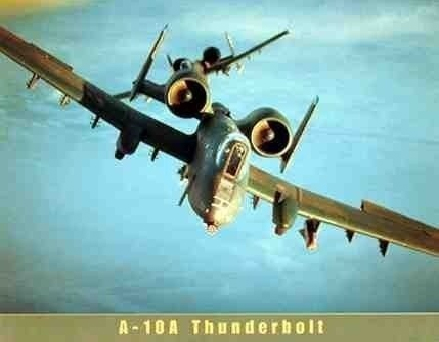
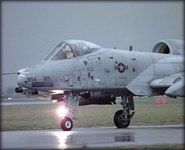
The
A-10, known among pilots as the Warthog, is designed to fly low and
destroy tanks. Each aircraft costs $8.8 million and takes a crew of one.
The A-10 carries a 30 mm GAU-8/A seven-barrel Gatling gun, and up to
16,000 pounds of mixed ordnance.
|
A-10
Thunderbolt (also known as "Warthog")
Primary
Function: A-10 - close air
support, OA-10 - airborne forward air control. Anti-tank.
Contractor:
Fairchild Republic Co.
Power Plant:
Two General Electric TF34-GE-100 turbofans
Thrust: 9,065 pounds each engine
Length:
53 feet, 4 inches (16.16 meters)
Height:
14 feet, 8 inches (4.42 meters)
Wingspan:
57 feet, 6 inches (17.42 meters)
Speed:
420 miles per hour (Mach 0.56)
Ceiling:
45,000 feet (13,636 meters)
Maximum Takeoff Weight:
51,000 pounds (22,950 kilograms)
Range:
800 miles (695 nautical miles)
Armament: One 30 mm GAU-8/A seven-barrel Gatling gun; up to
16,000 pounds (7,200 kilograms) of mixed ordnance on eight under-wing
and three under-fuselage pylon stations, including 500 pounds (225
kilograms) of Mk-82 and 2,000 pounds (900 kilograms) of Mk-84 series
low/high drag bombs, incendiary cluster bombs, combined effects
munitions, mine dispensing
munitions, AGM-65 Maverick missiles and laser-guided/electro-optically
guided bombs; infrared countermeasure flares; electronic countermeasure
chaff; jammer pods; 2.75-inch (6.99 centimeters) rockets; illumination
flares and AIM-9 Sidewinder missiles.
Crew:
One
Date Deployed:
March 1976
Unit Cost:
$9.8 million (fiscal 98 constant dollars)
Inventory:
Active force, A-10, 143 and OA-10, 70; Reserve, A-10,
46 and OA-10, 6; ANG, A-10, 84 and OA-10, 18
|
Mission
The A/OA-10 Thunderbolt II is the first Air Force
aircraft specially designed for close air support of ground forces. They are
simple, effective and survivable twin-engine jet aircraft that can be used
against all ground targets, including tanks and other armored vehicles.
Features
The A-10/OA-10 have excellent maneuverability at
low air speeds and altitude, and are highly accurate weapons-delivery platforms.
They can loiter near battle areas for extended periods of time and operate under
1,000-foot ceilings (303.3 meters) with 1.5-mile (2.4 kilometers) visibility.
Their wide combat radius and short takeoff and landing capability permit
operations in and out of locations near front lines. Using night vision goggles,
A-10/ OA-10 pilots can conduct their missions during darkness.
Thunderbolt IIs have Night Vision Imaging Systems
(NVIS), goggle compatible single-seat cockpits forward of their wings and a
large bubble canopy which provides pilots all-around vision. The pilots are
protected by titanium armor that also protects parts of the flight-control
system. The redundant primary structural sections allow the aircraft to enjoy
better survivability during close air support than did previous aircraft.
The aircraft can survive direct hits from
armor-piercing and high explosive projectiles up to 23mm. Their self-sealing
fuel cells are protected by internal and external foam. Manual systems back up
their redundant hydraulic flight-control systems. This permits pilots to fly and
land when hydraulic power is lost.
The Thunderbolt II can be serviced and operated
from bases with limited facilities near battle areas. Many of the aircraft's
parts are interchangeable left and right, including the engines, main landing
gear and vertical stabilizers.
Avionics equipment includes communications,
inertial navigation systems, fire control and weapons delivery systems, target
penetration aids and night vision goggles. Their weapons delivery systems
include heads-up displays that indicate airspeed, altitude, dive angle,
navigation information and weapons aiming references; a low altitude safety and
targeting enhancement system (LASTE) which provides constantly computing impact
point freefall ordnance delivery; and Pave Penny laser-tracking pods under the
fuselage. The aircraft also have armament control panels, and infrared and
electronic countermeasures to handle surface-to-air-missile threats.
Installation of the Global Positioning System is currently underway for all
aircraft.
The Thunderbolt II's 30mm GAU-8/A Gatling gun can
fire 3,900 rounds a minute and can defeat an array of ground targets to include
tanks. Some of their other equipment includes an inertial navigation system,
electronic countermeasures, target penetration aids, self-protection systems,
and AGM-65 Maverick and AIM-9 Sidewinder missiles.
http://www.af.mil/news/factsheets/A_10_OA_10_Thunderbolt_II.html
http://www.a-10.org/photos/photos2.asp
(photos)
http://www.fas.org/man/dod-101/sys/ac/a-10.htm
http://www.abcnews.go.com/sections/us/DailyNews/military_a10.html
|


|
F-111
Aardvark
Primary function:
Speed:
Armament:
Crew:
Mfg: General
Dynamics
Photos
|
F111 was
one of the first aircraft designed for "Safe Life" as a result of the
Aircraft Structural Integrity Program in the USA (1956). However, following
several early aircraft losses, it was realized that relatively small flaws
escaping detection during NDI at manufacture could lead to catastrophic failure
in the highly stressed, high strength steel structure following a period of
fatigue growth in a very short time frame. This led to the application of
fracture mechanics principle to aircraft design and was used in the F111
recovery program in the form of the cold proof test. At the test temperature of
- 40°C, the fracture toughness of the steel is reduced so that at
critical load, small flaws undetectable by NDI can cause catastrophic failure.
If the aircraft does not fail, then fracture mechanics principles can be used to
predict a period of safe operations before the "proof test" flaw size
grows to critical flaw size under normal operating conditions. F111 is the only
aircraft ever built to depend for safety of operation on this test. This paper
will briefly describe the history and technical basis for the Cold Proof Test,
shortly to be established at RAAF Amberley.
http://www.ndt.net/article/apcndt01/papers/912/912.htm
http://www.jlhull.com/aircraft/F111.htm
http://f-111.net/other.htm
http://photo.starnet.ru/Thematic_Wallpapers/Aviacija_i_kosmonavtika/Istrebiteli_i_shturmoviki/GD_F-111/pages/F111_6.htm
(photos)
http://web.bryant.edu/~history/h364proj/summ_99/trainor/fb_a.htm
Specifications
|
|
Primary
Function
|
Fighter/attack
|
|
Contractor
|
Lockheed
Aeronautical Systems Co.
|
|
Power Plant
|
Two General
Electric F404 engines
|
|
Length
|
65 feet, 11
inches (20.3 meters)
|
|
Height
|
12 feet, 5
inches (3.8 meters)
|
|
Weight
|
52,500 pounds
(23,625 kilograms)
|
|
Wingspan
|
43 feet, 4
inches (13.3 meters)
|
|
Speed
|
High subsonic
|
|
Range
|
Unlimited with
air refueling
|
|
Armament
|
Internal
weapons carriage
Two each of:
2
MK84 2000-pound
2 GBU-10
Paveway II
2 GBU-12
Paveway II
2 GBU-27
Paveway III
2 BLU 109
2 WCMD
2 Mark 61
|
|
Unit Cost
$FY98
[Total Program]
|
$122 million
|
|
Unit Cost
|
$45 million
|
|
Crew
|
One
|
|
Date Deployed
|
1982
|
|
Inventory
|
Active force,
54; ANG, 0; Reserve, 0
|
|
PMAI
Primary Mission Aircraft Inventory
Only
combat-coded aircraft and not development/ test, attrition reserve,
depot maintenance, or training aircraft.
|
36 aircraft
|
http://www.fas.org/man/dod-101/sys/ac/f-117.htm
(photos)
http://www.jetplanes.co.uk/f117.html
http://www.holloman.af.mil/photos/117pho.html
(photos)
http://www.geocities.com/CapeCanaveral/Hangar/3314/f117.html
http://photo.starnet.ru/Thematic_Wallpapers/Aviacija_i_kosmonavtika/Istrebiteli_i_shturmoviki/Lockheed_F-117/pages/F117_2.htm
(slide show)
http://www.airforce-technology.com/projects/f117/
http://www.af.mil/news/factsheets/F_117A_Nighthawk.html
|

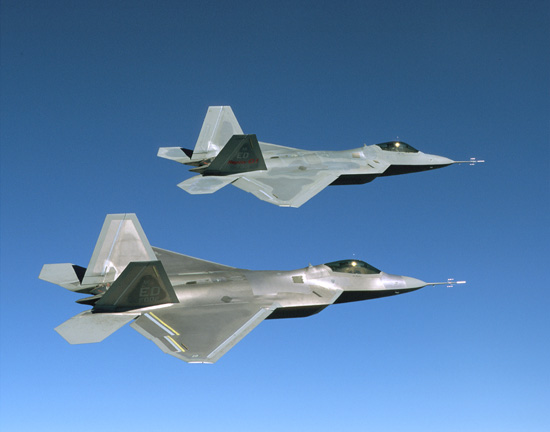
|
F-22
Raptor
Primary
function: Fighter/attack
Speed:
high supersonic
Crew:
Replaces:
F4, F111, F15
Wingspan: 44
feet 6 inches
Length:
62 feet 1 inch
Height: 16
feet 5 inches
Powerplant:
two F119-100 from Pratt and Whitney
Thrust: 156
kN
Auxiliary
power unit: G250, 335 kW Allied Signal Aerospace
Weapons:
M61A2 Vulcan Cannon
AIM-9M Sidewinder missile
AIM-120 AMRAAM Advanced Medium Range Anti-Air Missile
Joint Direct Attack Munition
F-22
Video
|
|
  The
F-22 is being developed to counter the increasing sophistication and
threat of hostile air forces and integrated air defense systems in use
around the world. This fighter will provide air dominance and a
precision ground attack capability for US forces well into the 21st
century.
The
F-22 is being developed to counter the increasing sophistication and
threat of hostile air forces and integrated air defense systems in use
around the world. This fighter will provide air dominance and a
precision ground attack capability for US forces well into the 21st
century.
|
http://www.f-22raptor.com/index_ie.htm
http://www.f22-raptor.com
http://www.codeonemagazine.com/f22/index.html
http://www.af.mil/lib/airpower
http://www.boeing.com/defense-space/military/f22/f22photos.htm
http://www.airforce-technology.com/projects/f22/index.html
missing JSF (Joint Stroke Fighter)
missing F-104
return
to top





















